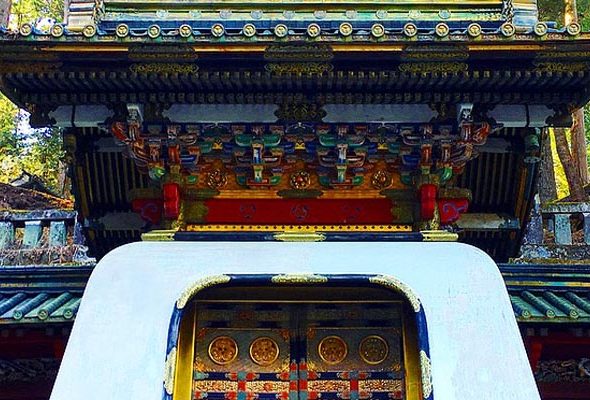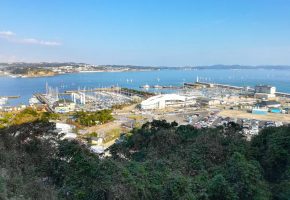# tokyo

A working holiday should not only be about work but also about discovering the country. There is so much to see and experience in Japan that you should not miss out on while you are here! We wanted to get out of Tokyo city life for a long weekend and it wasn't difficult to decide on Nikko. Only a 2-hour train ride away from Tokyo, this town in the hills makes for a perfect weekend getaway if you want to sniff some culture and be surrounded by nature. We booked the Turtle Inn Nikko Annex Hotel which is not too far from the train station with its own onsen (Japanese style hot spring), and after dropping off our luggage in the lobby and getting some good advice from the receptionist for our stay we headed out for our first lunch in Nikko. Of course we wanted to try yuba, a by-product of tofu production that is ubiquitous in Nikko, being a center of Buddhist activity since its foundation. We found this cute little udon noodle restaurant called Kanman Teahouse that served yuba as a side dish, perfect for our lunch. The yuba was very smooth and flavorful, and we loved the cold udon and tea with Japanese sweets that we got afterward. A good start of our weekend Our First Day: History and Beauty Then it was time to immerse ourselves in Japanese history. After passing through a foresty road with old jizo statues we headed to the Tamozawa Imperial Villa Memorial Park. Here you can walk around the huge Japanese style villa that used to be the vacation home of the imperial family. It's not just the house that breathes a quiet atmosphere, the garden also makes for a peaceful little stroll in a typical Japanese garden. If you come at the right time you can also see a very old Sakura tree bloom. This was the green oasis we were hoping to find when we left Tokyo! As a visit to Nikko is not complete without visiting its main shrine, the Toshogu, it was next on our list. As expected there were many tourists, foreign as well as Japanese, but we could also easily tell why this shrine complex is so popular. Its wood carvings are exquisite, there are so many beautiful little details that the buildings are like pieces of art. At several locations within the complex priests carried out Shinto rituals in order to bring fortune to the people, and stones on the ground were arranged to look like turtles to bring good luck. What most people don`t know is that it is worth it to walk the extra 1.5 kilometer up the hill on the east side of the temple. Here you can find the rarely visited Takio shrine in the middle of the woods, surrounded by small water streams. We enjoyed being away from the crowds and savored the silence. By the time we left the Takio shrine it was getting dark, meaning it was time to look for a place to eat because restaurants and even bars close early in Nikko (and other places outside the big cities in Japan for that matter). We decided on Bar de Nikko because of its good reviews on TripAdvisor, and we did not regret it. The food was delicious and nicely presented, and there was a large assortment of drinks available. It was open until 21.00, which is quite unique in this small town. In the evening we soaked in the hotel onsen with a nice view of the fast streaming river outside through a large window and went to bed early. The Second Day: Hiking and Nature One of the purposes of the trip was to get out there and take a long walk in a beautiful, natural area. We wanted to breathe some nice, fresh air in the spring sun! We took the bus to the Chuzenji lake, an area that used to be a popular place to vacation for foreigners as well as well-to-do Japanese people. As we were there late March it was still off-season and very quiet. We first stopped by the Kegon falls, we didn't pay the few hundred yen to go downstairs and see the waterfalls up close, but I would recommend doing it anyway because I later heard from others who have gone down there that it was worth the money. We then walked almost all the way along the northern shore of the lake, which was great as we barely saw anyone else as soon as we left the little town. It was peaceful and quiet, and we walked around 4 kilometers before we got to the boathouse where we were surprised to find the restaurant open. Of course we were the only customers, but the noodles (yes, again as they are so good here in Nikko) were tasty and we were ready to go again. As we went more inland the road went up, and after 2 kilometers or so we hit a trail up Mt. Takayama. Feeling adventurous we went in even though the sign warned us of bears and deers, the former scaring us a bit more than the latter. But the trail was snowy, and after taking a selfie of the 'courageous us' and the snow we decided to turn around and go find the Ryuzu Falls which we came here to find. We soon found fast streaming clear water and went down the trail to see a cute tea house overlooking the falls which are named after the dragon it resembles. They served delicious ice-cream with the flavor of, you guessed it, yuba. It might be a surprising flavor, but it was actually surprisingly good! We then took the bus back to the hotel and ended up having the most thrilling part of our trip, a ride down the Iroha slope. I'm sure the driver knows this road like the back of his hand, but sitting right behind him and seeing the bus steer dangerously close to the slope's edge with a drop of a few hundred meters deep behind it about 20 times, made for a blood-curdling ride. I think Julia was very happy when we were back at 600 meters above sea level again instead of the over 1000 meters that we were above sea level before. After all this excitement we first went for a long soak in the hotel onsen again before we went out for dinner again. This time we went to a Chinese restaurant near the hotel that was almost completely full, a good sign. The food was indeed delicious, I would just stay away from the hot sake as I could tell why it was sold as hot sake instead of chilled or at room temperature. We then headed back to the hotel for some card games and our futons. The Last Day: A Temple and an Old Hotel After having a perfect brunch in the Kanaya Hotel Bakery (very much recommended) we first visited the museum right next door. Kanaya hotel was once the first hotel where Westerners could stay during the period in Japanese history when foreigners were still very rare in Japan and couldn't always stay in a regular Japanese hotel. The people who work there conduct short tours, most of them don't really speak English but it is still nice to hear a bit of simple explanation of what you see. Some parts of the hotel are original which is quite rare to see in Japan, especially in Tokyo as most buildings don't last this long here. We then went to our last stop on this trip, the Taiyu-in temple. What we loved here was that it was so much quieter than at the Toshogu, and it was a lot easier to relax and enjoy our surroundings. There was another mass blessing ceremony, and there were 4 beautifully colored statues near the main hall. For those who like wood sculptures, there was also a lot to see, as almost every animal was represented somewhere in the decorations on the walls. Some parts of this temple reminded me a bit of Persian or oriental art with the many colors and wood carvings. Also, we were not sure if we were supposed to go here, but a bit east of this temple up a hill there seems to be an abandoned temple with a vshery big statue in a closed off hall. There was almost no one there and it looked like no one was taking care of it, so it was a bit spooky over there. It was unfortunately already time to go home by the time we came back to the main road, but we didn't leave before a last bowl of noodles, ramen this time, and a Harajuku style desert near the station. If you are on a working holiday (or regular holiday for that matter) in the Tokyo area, you should definitely not skip Nikko. As they say in this locale: don't say 'kekkou' (I'm good) until you have been to Nikko! " order_by="sortorder" order_direction="ASC" returns="included" maximum_entity_count="500"] About the Author Stefanie has lived in Japan for 5 years, and is working as a coordinator for World Unite! since 2017. Together with her colleague Julia she decided to get out of Tokyo city life for a long weekend.
Most people who come to Tokyo know of the Skytree, the Tokyo Tower and the Shibuya Crossing with loyal Hachiko statue. Those are of course awesome places to visit when you are here, but how about some lesser-known but amazingly Japanese sights in the concrete jungle? Let me introduce to you these 5 quintessential Japanese scenes in the middle of Tokyo! 1. Bonsai Trees in Happo En This is one of the best places to see bonsai trees, as some of the trees that are on display here are already 500 years old! Pruned to perfection using traditional gardening techniques, these trees are more like masterpieces of art than anything else. Imagine all the work that went into a tiny tree that's hundreds of years old and grows exactly the way the bonsai expert wants it to grow. It is not a coincidence that an art that refined originated in partly Buddhist Japan. Besides the bonsai trees, the rest of the garden is also perfectly landscaped. It is no wonder that this is also a very popular place for young couples who can afford it to get married here and have their pictures taken in the garden. If you are lucky you might catch a few weddings and see what a bride and groom look like in their Shinto wedding dresses. They often pose near the pond full of happy and healthy koi fish. While you are there you should also not forget to stop by the tea house in the back of the garden and have a cup of matcha tea with some of the best Japanese sweets available in the city. The lady will serve you using Japanese-style small movements, where not one movement is unnecessary. Add to this the view, and you're all set for a perfect afternoon tea! 2. Godzilla in Shinjuku Ever since Hollywood did a remake of classic Japanese movie 'Godzilla' this legendary beast has been gaining popularity again. This dragon, who is actually a metaphor for nuclear weapons, even has a life-size replica of itself in the middle of entertainment-district Shinjuku in Tokyo. The best part is that it is not just a statue, at set times every day this monstrous movie villain even starts to roar and breathe steam starting at noon, and you shouldn't miss this! Especially at night, it is quite an impressive free show for everyone to see. Go with your fellow Working Holidayers to Shinjuku to watch the spectacle and after that have a yakitori meal in the alleyways of Omoide Yokocho. If you stay in the World Unite! sharehouse you will always be able to find someone who wants to go with you and explore the city. 3. Mario and Luigi in the Streets of Tokyo Even if you have always seen Tokyo as a city that is often featured in video games, you might still be surprised to hear that the streets of Tokyo do actually look like a real-life video game at times! It's only been a few years since the first Mario carters were spotted, and nowadays they became a part of daily Tokyo traffic. If you bring an international driving license to Japan, you will be able to dress up like your favorite Mario Cart character and drive the streets of Tokyo with an actual go-kart. So when you have a driving license and come to Tokyo, make sure to bring your international license and be part of the real-life Mario cart craze! 4. Japanese Idols in Akihabara For those who are not in the know, Japanese idol bands are (usually) large groups of high-school aged girls who mainly appeal to middle-aged men who are looking to relive their good old young days. The music they produce is maybe not the best, but the cuteness of the girls is enough to draw large crowds to their concerts. Akihabara is the birthplace of one of the most iconic Japanese idol bands: AKB48. The group's name stands for Akihabara (AKB) and the number of members (48). The girls are continually replaced as they become too old around age 24. Those who retired or didn't quite make the cut sometimes become waitresses at the AKB48 cafe where above picture was taken. This cafe doesn't only serve cute dishes that are said to be band members' favorites, but they also organize quizzes about the band and small performances on their in-cafe stage. 5. Votive Tablets Adorned with Anime in Kanda Every shrine (Shinto) and every temple (Buddhist) has their own image on the ema (votive tablets) that people use to write their wishes on. Usually this image has a relationship with either the temple or shrine itself or the neighborhood the temple or shrine is located. As the Kanda shrine is located near anime fan paradise Akihabara, the ema here are decorated with anime pictures. Some of them have been drawn by the fans themselves and are quite impressive. It is an interesting combination to see, a traditional solemn shrine coupled with these colorful, modern pictures! About the author Stefanie has lived in Japan since February 2013, and after starting the Japanese adventure in Nagoya she happily settled in Tokyo in 2014. She loves exploring the city, and besides her work as a coordinator for World Unite! she also works as a tour guide in Tokyo. If participants of the World Unite! program in Japan have questions about exploring Tokyo, they can always ask Stefanie which places can't be missed. She also believes that the best Working Holiday experience includes not only work to boost your skills and resume, but also plenty of exploration of Tokyo as well as the rest of Japan.
Enoshima, a small island in Kanagawa Prefecture, is a popular resort and sightseeing place. A bridge connects the island with the shore area making it easy for visitors to walk there and enjoy the beautiful coast view. The Road to the Sea Candle Garden When you arrive at the island, you will see many tourist souvenir shops in a narrow street sloping slightly upwards to a post office. It has the special charm of a traditional rural town and a beautiful Shinto gate (torii) at the end of the street. When you walk towards the gate you will pass many small restaurants and street food stands with mostly seafood offerings. On hot days you can indulge in one of the many ice cream shops there. Climbing up the stairs you will find some Shinto shrines where you can pray and buy charms for various purposes, such as luck, health, love and traffic safety. Enoshima is also a very popular place for Japanese visitors. You will see many Japanese families with their small children and couples on a romantic trip. After enjoying the serene atmosphere at the temples you will reach the main attraction of Enoshima Island, the Sea Candle and the Sea Candle Garden. The tropical garden has many small walkways decorated with hundreds of colorful glasses with candles inside. There is a romantic and fascinating atmosphere when you go there by night, but also during the day it's a wonderful place to visit. For a nice view of the harbor area, look for the cafés where you can admire the view while enjoying some good food or drinks. Sea Life During the summer season the beach area around Enoshima is full of people who love water sports such as surfing, swimming or sailing. Another popular activity in this area is fishing. If the weather outside isn't comfortable you can visit the Enoshima Aquarium, which features a great collection of marine animals and even has a dolphin show. Enoshima makes for a great day trip, and not least because of its famously fresh seafood. When the weather is crisp and clear it's even possible to have a great view of Mount Fuji. If you come from Tokyo by train you will most likely visit Kamakura first on the way down to Enoshima. If you're visiting both places buying the Kamakura-Enoshima Pass for 700 yen in Tokyo is a good option. You can also go to Kamakura by local trains and buy a 1-day pass for the Enoshima Electric Railway (Enoden) for 600 yen. This pass allows you to stop at popular temples in Kamakura as well as in Enoshima.



